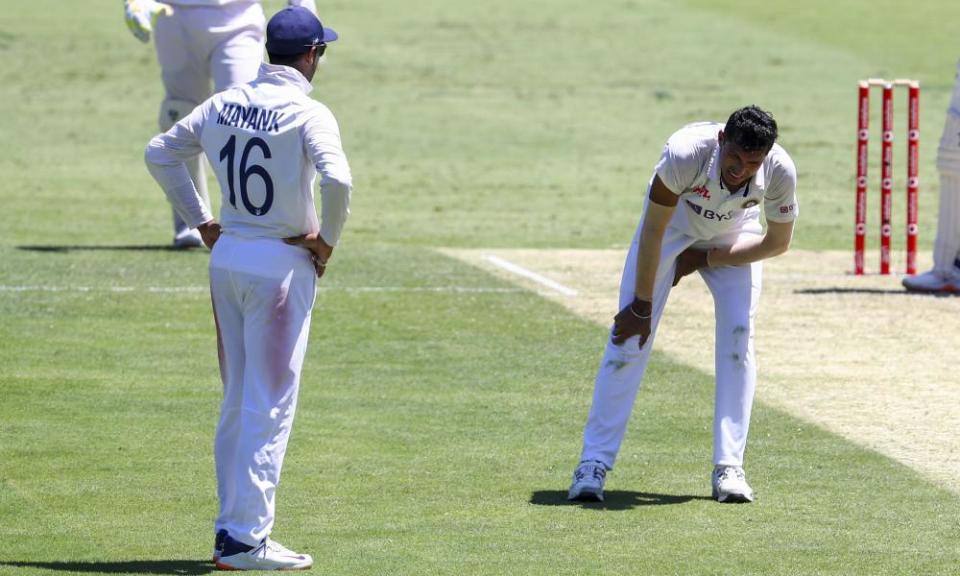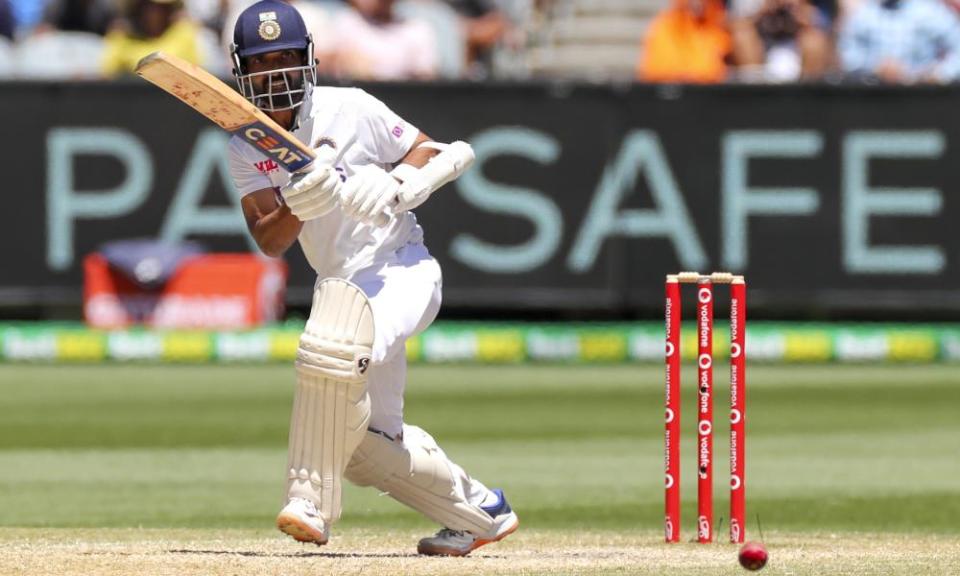Bouncers, sledging and mischief: why Australia v India is series for these times
Every man has his breaking point. You and I have one. Navdeep Saini, India’s seventh-choice seam bowler, reached his at The Gabba on Friday morning.
Let’s take a walk, for a moment, down that quarantined hotel corridor. It is now five months since India’s cricketers began their bubble-bound odyssey across the continents, from Dubai to Sharjah to Sydney and Melbourne, ferried in sealed isolation from airport to hotel to empty concrete bowl.
Related: Gabba a fitting venue for Nathan Lyon's 100th Test milestone | Adam Collins
Fast forward to this week and the players have arrived in Brisbane. Already bruised and homesick, they find they will also be doing their own housekeeping, their meals delivered by a local Indian restaurant.
Either side of which they must process their aching minds and bodies through the mince-machine, the whirling cleavers of the Gabbatoir. Requests are made for a little slack: use of the hotel pool, maybe some room service. In an enjoyable twist Alyssa Healy, also an international cricketer and the wife of the opposition quick Mitchell Starc, who has just broken your mate’s thumb, issues a perfectly pitched sledge via Twitter, letting you know that on top of it all you’re a whinging vessel of entitlement who really should wind it in.
Saini, who has walked through all this, makes it on to the Gabba turf for the final Test. Just after lunch on the opening day he gets a ball to leap up and take the edge of Marnus Labuschagne’s bat, only to see a simple catch go down in the gully.
In the same moment, with the strain of those five airless months crashing through his nervous system, Saini collapses in agony with a twanged groin and is carried off. Australia would have been 93 for four. Labuschagne goes on to score 107.

Australian cricket fields always have a dream-like quality from the other side of the world, that square of warm light bounced into the gloom of an English winter. The grass is a vivid lime green, the sun a pale glare.
Even the players look like an alien race of happy outdoor creatures. Plus, of course, all sport has a tendency to seem disproportionately vital in the moment, none more so than Test cricket, with its series arcs, its rolling narratives.
But still, Australia versus India really has been something else entirely. And not just because this is already one of the great Test series. Something else is going on here.
Sport in the pandemic era has a tendency to feel forced, a gaudy TV circus offering false notes and tinny distraction. This, though, is another world: not just the single most absorbing sports event of the lockdown months, but a series that has carried a startling emotional depth.
This has been a symphony in the round, from Rishabh Pant’s thrilling defiance to Steve Smith 'finding his hands' again
Mainly it has been seriously good cricket, throbbing with back-stories and subplots. India collapsed to 36 all out when they were ahead in Adelaide, came back to win the next one, then produced an exhilarating rearguard to draw in Sydney.
They arrived in Brisbane missing the best fast bowler and best spinner in the world, plus four others, plus now the persevering Saini. Still, though, you can feel their resistance.
Ajinkya Rahane has been a hugely admirable surrogate captain for the more excitable Virat Kohli. Rahane has a way of standing, a way of walking that radiates command, endearingly upright and whiskery, like some honourable woodland creature, a field marshal in the hedgehog army.
His hundred in the second Test to resurrect the series was high-craft and beautifully calm. This was an innings that carried Indian Test cricket in that moment, and in some small sense the future of the format itself.

This has been a symphony in the round, from Rishabh Pant’s thrilling defiance with the bat, to Steve Smith “finding his hands” again. We’ve had bouncer wars, sledging apologies and mischief-making over Smith scratching about harmlessly at the crease.
We saw the wonderfully charismatic Mohammed Siraj shedding tears during the national anthem in Sydney – Siraj, who began playing with a hard ball only five years ago, drew a nick from David Warner with the sixth ball of the first day in Brisbane.
None of which quite explains the weirdly moving nature of this series, the feeling of something oddly connected being played out.
There are other strands here. The Gabba, for example, is a daunting place for Australia too, a place where the country’s sense of its own sporting ultimacy resides. The thought of being bounced out there by a battery of aggressive Indian seam bowlers is a quietly terrifying prospect for the Australian sporting psyche.
But this is mainly about Test cricket itself. There is a reason no other sport can carry such emotional depth in these strange times. Test cricket is above all about resistance. This is a sport of patience, transcendence, blows received and absorbed.
If Australia versus India has been a Covid-era centrepiece, one sporting event I for one will actually remember, it is because it reflects to some degree what we are currently doing.
Test cricket rewards endurance. It feels in its highest form like an act of species-resistance. Here they are, the humans, conducting their complex physical art form on an isolated strip of green, like the orchestra playing on while the sea waters rise.
Along with every other sport, this cussed old game wouldn’t even be going on without the pressure of TV deals to fulfil. India’s players would not still be trapped within their bubble. A green field in Brisbane would not have become such an uplifting source of distraction.
But it is, it turns out, the perfect occasion for now: sport-as-life at a time when very little else out there makes quite this much sense.

 Yahoo Finance
Yahoo Finance 